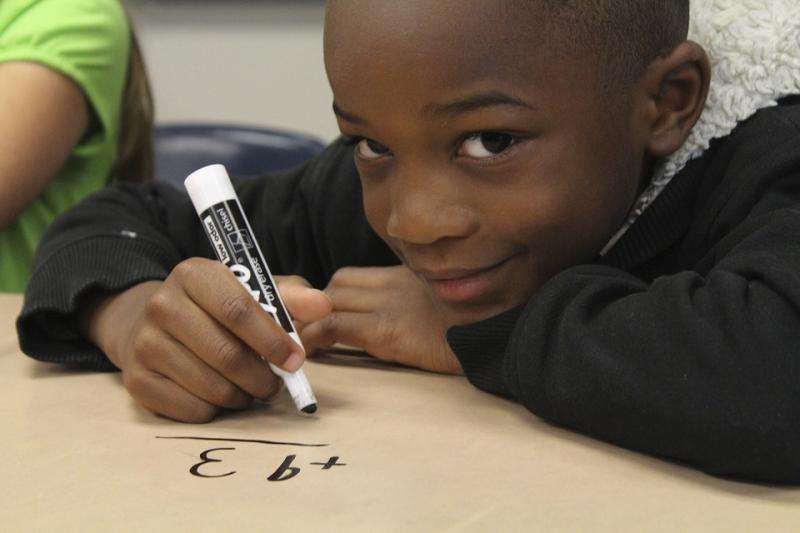External structures can stymie policies designed to improve education for minority students

Education policy is of topmost interest to Jurée Capers, an assistant professor of public management and policy in the Andrew Young School. Her research puts a different spin on the subject, though, by examining the structures inside and outside educational institutions that impact underrepresented populations.
"In general, I explore how institutions like school districts or schools affect outcomes for those groups," she said. "My interest is public administrators and how they carry out their jobs within the broader structure. For example, structural racism and institutional biases are being discussed now. I want to learn more about how people operate in these structures that dictate what they do."
When Michael Brown, an unarmed black teenager, was shot and killed by a police officer in Ferguson, Missouri, on August 9, 2014—the week before Capers taught her first Race and Public Policy class at Georgia State—she entered a classroom full of students upset that the officer would probably be exonerated.
"The shooting was a structural issue. The officer didn't violate the law, but the policy he followed was structurally flawed. If a person's job is to carry out flawed policy, that's what he is going to do," she said.
"I use this structural framework in both my research and teaching. I want students to understand that many of their policy concerns are not with the people who implement policies, but with the design of those policies."
Capers' latest research was suggested by her dissertation, which examined why school districts would continue to pursue desegregated schools when the courts have suggested there's no need, and the effect this decision has on school boards, teachers and students.
"As I was working on that idea, I realized the systems in racially balanced, diverse schools and districts are probably a little different than those in segregated schools, but I didn't know how," she said. "One way may be how the persons inside these two different school environments interacted with the students. How do their environments shape them? Learning about the effect that schools, or their policy environments, have on education officials is a structural question."
For "The Effect of the External Environment on Bureaucratic Representation: Assessing the Passive to Active Representation Link" (American Review of Public Administration, 2017), Capers used data from the nation's 1,800 largest school districts to compare the level of disparity in academic grouping across racial groups in two distinct environments: racially balanced and racially imbalanced school districts.
She expected to find desegregated school districts would offer more opportunities in gifted education for minority students.
"In the desegregated school districts, I expected to find that the minority teachers would be aware of the inequitable treatment minority students received, and they would try to do even more to reduce inequality within those districts," she said. "In segregated schools where the pool of minority students is larger, minority teachers may not feel they need to do that."
Capers looked at the data to reveal two ideas. First, if the two types of school districts offered different student demographic ratios, would their gifted education programs also reflect those ratios? She also looked at whether minority teachers would do something about any disparities.
"Earlier education and public administration research says that black and Latino students should begin to get recommended more often for gifted programs when they have more black and Latino teachers because minority teachers are likely to 'actively represent' the students; the teachers will use their positions to direct tangible gains towards people of the same race, gender or class. They'd stand up to be sure there's more equality in the schools," she said. "The literature says that should be so."
Capers wanted to know whether that idea holds in the different school environments. To find out, she looked at the interactive effect between the percentage of black and Latino teachers and the racial balance of the districts. "In theory, if the school environment can influence teachers' actions, as the district becomes more balanced, the work of minority teachers to ensure equity in their schools' gifted programs could change in a way that reflects the interest and benefit of the school environment.
"In other words, the school environment could make it more challenging for minority teachers to use their positions to push for equity in gifted education for minority students," she said.
Capers found that minority students experienced underrepresentation in gifted education courses in both the desegregated and segregated districts. Also that they were more likely to be underrepresented in the desegregated school districts.
"Although minority teachers used their positions to improve the odds for assigning minority students to gifted education and reduce their underrepresentation, I found that the school environment can moderate their active representation. The effect that black teachers had on gifted education decreased as the schools became more racially balanced."
Capers acknowledged that other outside influences, which had not been tested, could play a role in the findings. Resource dependence—or the school's dependence on the external environment for students and tax funding—and the action of parent/teacher organizations and teachers unions may also influence how teachers use their discretion.
"As the school changes or desegregates, we begin to see less of the promotion of the minority student by the minority teacher. Segregated environments seem to be more supportive of minority students than the desegregated environments," she said. "These findings, overall, reveal the impact that structures—in this case, two distinct school environments—can have on both teachers and students."
Capers' research supports her theory that structural factors are important in predicting student outcomes.
"The broad assumption and desegregation literature finding that desegregated schools are better for minority students is not supported. There are institutional challenges in desegregated schools that undermine the opportunities that minority students receive," she said. "The racial balance of school districts is a structural factor that should continue to be considered in discussions of school equity, quality and performance."
Provided by Georgia State University
















